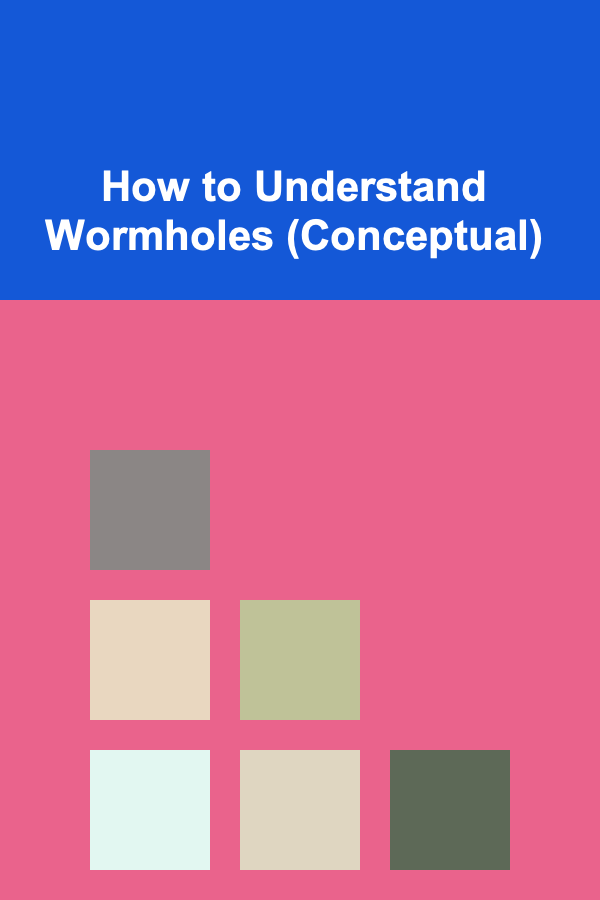
How to Understand Wormholes (Conceptual)
ebook include PDF & Audio bundle (Micro Guide)
$12.99$7.99
Limited Time Offer! Order within the next:

In the realms of theoretical physics and science fiction, few concepts evoke as much wonder and mystery as wormholes. These cosmic shortcuts, also known as Einstein-Rosen bridges, have captured the imagination of both scientists and the general public alike. While wormholes remain a hypothetical concept, they have become a cornerstone of discussions about the nature of space, time, and the possibilities of interstellar travel.
In this article, we will explore the conceptual understanding of wormholes, diving into the science that underpins them, the history of their discovery, and the role they play in our broader understanding of the universe. From their relationship with Einstein's theories to their portrayal in popular culture, this piece aims to provide a deep and comprehensive exploration of wormholes, as well as the potential implications they hold for the future of science and technology.
What Is a Wormhole?
At its core, a wormhole is a theoretical structure that connects two distant points in space and time. Imagine a piece of paper with two holes in it. If you fold the paper so that the two holes align, you create a shortcut between them, allowing you to travel from one hole to the other instantaneously, without traversing the space in between. This simple analogy captures the essence of a wormhole, although the true physics behind it is far more complex.
A wormhole is often depicted as a tunnel with two ends, each located at separate points in space and time. The concept is rooted in Albert Einstein's theory of General Relativity, which describes how space and time are intertwined into a four-dimensional fabric known as spacetime. Wormholes, according to this theory, are solutions to the equations that govern spacetime, forming "shortcuts" through the fabric of the universe.
The term "wormhole" was coined by physicist John Archibald Wheeler in 1957, but the idea itself has its origins in earlier works on the nature of spacetime and gravity. The idea was first explored by Einstein and his colleague Nathan Rosen in the 1930s, when they developed the concept of the "Einstein-Rosen bridge," a type of wormhole. While the theoretical framework for wormholes is rooted in relativity, the idea of these cosmic tunnels quickly captured the imagination of science fiction writers and enthusiasts.
Einstein's Theory of General Relativity and Wormholes
To understand how wormholes are theoretically possible, we must first delve into the basics of General Relativity. Einstein's theory, published in 1915, revolutionized our understanding of gravity. Rather than treating gravity as a force between masses, General Relativity describes gravity as the warping of spacetime itself due to the presence of mass and energy.
Imagine spacetime as a rubber sheet. When you place a heavy object, like a bowling ball, on the sheet, it creates a dent or curvature in the fabric. Smaller objects, like marbles, will move along the curved surface, appearing to be attracted to the bowling ball. In a similar way, massive objects like planets and stars curve the spacetime around them, causing objects to move along curved paths. This is what we perceive as gravity.
In the context of wormholes, the curvature of spacetime allows for the possibility of shortcuts. Just as a deep enough dent in the rubber sheet could allow objects to pass through different points, spacetime itself could, in theory, be warped to create a tunnel-like structure that connects two distant regions of the universe. This hypothetical tunnel is the wormhole.
Einstein and Rosen's original idea involved a bridge between two black holes, where one end would be the entrance to a black hole and the other end would be the exit. This structure, which would connect two separate points in spacetime, is what we now refer to as an Einstein-Rosen bridge.
Types of Wormholes
There are several theoretical types of wormholes that physicists have explored. While all of them share the basic concept of connecting two separate points in spacetime, they differ in terms of their structure, stability, and practical implications.
1. Traversable Wormholes
A traversable wormhole, also known as a "wormhole of convenience," is the type of wormhole that most people are familiar with from science fiction. It is a wormhole that, in theory, could allow for the travel of matter, such as spacecraft or humans, through it. The key feature of a traversable wormhole is that it must remain open long enough to allow objects to pass through it without collapsing or causing harm to the traveler.
In the theoretical models of traversable wormholes, it is often assumed that exotic matter---matter with negative energy density---would be required to keep the wormhole open. This exotic matter would counteract the immense gravitational forces that would normally cause the wormhole to collapse. The existence of exotic matter remains hypothetical, and whether it can be created or harnessed is an open question in modern physics.
2. Wormholes and Black Holes
In addition to traversable wormholes, black holes themselves are closely related to the concept of wormholes. According to General Relativity, black holes are regions of spacetime where gravity is so strong that nothing, not even light, can escape. These regions are characterized by a boundary called the event horizon, beyond which no information can escape.
Einstein-Rosen bridges, as described earlier, were originally theorized as connections between two black holes. In this scenario, one black hole would serve as the entrance to the wormhole, and the other would serve as the exit. However, the conditions near a black hole are so extreme that any object attempting to pass through an Einstein-Rosen bridge would be crushed by the immense gravitational forces before it could reach the other side. Thus, while black holes may harbor the theoretical basis for wormholes, they are not practical for human travel.
3. Wormholes and Time Travel
Wormholes have also been linked to the idea of time travel. In certain theoretical models, a wormhole might not only connect two distant points in space, but also two different points in time. This opens up the possibility of traveling backward or forward in time. However, the concept of time travel through wormholes raises numerous paradoxes, including the famous "grandfather paradox," which questions the implications of changing events in the past.
Theoretical physicist Kip Thorne has explored the idea of time travel through wormholes, suggesting that if a wormhole could be stabilized and manipulated, it might allow for time travel. However, this would require manipulating spacetime in ways that are far beyond our current technological capabilities and understanding of physics.
Theoretical Challenges and Limitations
While the concept of wormholes is fascinating, there are several significant challenges that make them purely theoretical at this point. Some of the most important limitations include:
1. Exotic Matter and Energy
As mentioned earlier, one of the key requirements for a traversable wormhole is the presence of exotic matter with negative energy density. While exotic matter has been predicted by certain quantum theories, its existence has yet to be confirmed. Moreover, even if exotic matter could be found or created, it is unclear how it could be harnessed to stabilize a wormhole and keep it open for practical use.
2. Stability and Safety
Even if a wormhole could be created and stabilized, there are still significant concerns about its stability. According to some theoretical models, wormholes are inherently unstable and would collapse before anything could pass through them. Furthermore, the intense gravitational forces near a wormhole's entrance and exit could cause harm to any object that attempts to traverse it.
3. Wormholes and the Laws of Physics
Wormholes, especially those that allow for time travel, raise numerous questions about the fundamental laws of physics. Theoretical models of wormholes often involve violations of causality, where events could occur in reverse order or where paradoxes could arise. This challenges our current understanding of time and causality, and any attempt to create or use a wormhole would require a deeper understanding of the fundamental principles governing the universe.
Wormholes in Popular Culture
Wormholes have become a staple of science fiction, appearing in countless movies, books, and TV shows. One of the most famous depictions of a wormhole in popular culture is in the 2014 film Interstellar, directed by Christopher Nolan. In the film, a wormhole is discovered near Saturn, allowing astronauts to travel to distant planets in search of a new home for humanity. The movie's portrayal of a wormhole is visually stunning and scientifically grounded, thanks to the involvement of physicist Kip Thorne, who provided the scientific basis for the film's depiction of wormholes.
Wormholes have also appeared in many other science fiction franchises, including Star Trek , Stargate , and Doctor Who. These portrayals often focus on the idea of interstellar travel, with characters using wormholes as a shortcut to travel vast distances across the universe. While these depictions are speculative and often stretch the boundaries of current scientific understanding, they help fuel public interest in the concept of wormholes and their potential for exploration.
Conclusion
Wormholes are one of the most intriguing concepts in theoretical physics, offering a potential shortcut through the fabric of spacetime. While the idea of traveling through a wormhole is still purely hypothetical, the scientific principles behind them are grounded in the well-established framework of General Relativity. Despite the significant challenges and uncertainties surrounding wormholes, they continue to capture the imagination of both scientists and the public, offering a tantalizing glimpse into the potential of the universe.
As our understanding of the cosmos continues to evolve, the possibility of discovering or creating wormholes remains an exciting frontier for future research. Whether wormholes will ever become a practical reality or remain confined to the realm of science fiction is uncertain, but the pursuit of knowledge about these enigmatic cosmic phenomena is a testament to humanity's endless curiosity and drive to explore the unknown.

How to Create a Family Command Center for Organization
Read More
How to Create a Monthly Garden Maintenance Checklist
Read More
How to Soundproof Your Home Against Street Traffic Noise
Read More
Building a Strong Employer Brand: A Deep Dive
Read More
How to Create Beaded Earrings with Unique Dangles
Read More
10 Tips for Using a Health Planner to Improve Sleep Habits
Read MoreOther Products

How to Create a Family Command Center for Organization
Read More
How to Create a Monthly Garden Maintenance Checklist
Read More
How to Soundproof Your Home Against Street Traffic Noise
Read More
Building a Strong Employer Brand: A Deep Dive
Read More
How to Create Beaded Earrings with Unique Dangles
Read More